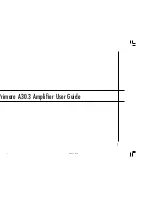
Circuit Description — Type Z
sistor, Q8672. The bias of V7618A is the collector-to-base
voltage of Q7618 plus the drop across Q8672.
The screen of the input cathode follower V7613 is con
nected back to its cathode through another cathode fol
lower, V7623A, and zener diode, D7621.
The screen
voltage of V7613 will therefore follow variations in the
cathode voltage (because it is “ bootstrapped" to the
cathode), approximately 105 volts above the cathode.
Capacitor
C7626
bypasses high-frequency components of
the signal directly to the screen. C7621 and R7622 form
a low-pass filter to remove zener noise from the screen
of V7613.
The gain of the input CF's (V7613 and V8613 approaches
unity because the impedance of the constant-current cathode
“ long-tail” approaches infinity, and because of the high
and constant grid-screen /x.
The grid-screen /x remains
constant because of the constant screen-cathode potential.
The most significant factor which reduces the gain of the
stage below unity is the cathode-load resistors R7620,
R7621, and R8621.
Slight circuit imbalances, principally in triode /x and
zener diode impedance, necessitate a balance control
R7620. For all practical purposes, this control, plus R7621
and R8621, form the cathode load for the input cathode
followers.
Differential Amplifier Stage
Signals from the input cathode followers are applied to
the grids of the Differential Amplifier stage, V7634 and
V8634. The cathode circuitry of the stage consists of a
constant-current circuit and a gain adjustment network.
The constant-current circuit is formed by Q8638 and V8638
and is identical in principle, with one exception, to the
operation of the circuits in the Input Cathode Follower
stage. The exception is that one constant-current circuit
supplies both tubes in this stage.
The amount of current supplied by the constant-current
circuit is determined by the setting of the G A IN ADJUST
control R8639. As screen-to-cathode voltage is maintained
constant, R8639 controls the transconductance of V7634 and
V8634, thereby controlling the gain of the stage.
The
control is set to provide the correct vertical deflection fac
tors when the VAR. ATTEN. control R7633 is set fully clock
wise. The VAR. ATTEN. control varies the gain of the Dif
ferential Amplifier stage by varying the cathode degenera
tion.
To prevent trace shift as the VAR. ATTEN. control R7633
is adjusted, the cathode potentials must remain equal. This
is accomplished by proper adjustment of the VAR. ATTEN.
BALANCE control R7619. Adjustment of R761 9 varies the
grid (and the cathode) voltage of V7634 and V8634 in
opposite directions to compensate for slight differences in
operating characteristics of the two tubes. Proper adjust
ment of R7619 will result in equal voltages at the cathodes
of V7634 and V8634 for all positions of the VAR. ATTEN.
controls.
As in the Input Cathode Follower stage, the screen volt
age for the Differential Amplifier stage is “ bootstrapped”
140 volts above the cathode. Because total cathode current,
screen-to-cathode voltage, and the plate-to-screen current
ratio remain constant, the plate currents of the Differential
Amplifier stage respond only to differential signals.
The high-frequency response of the Differential Amplifier
stage is improved by the use of series-shunt peaking in the
plate circuits.
This peaking is provided by L7632 and
L8632.
The AMPLIFIER DC BAL. control R7640 adjusts the base
voltage of Q7644 by forcing a small current through R7632.
The control is used to dc balance the Output Amplifier
Stage. Adjustment of R7640 forces the base of Q7644 to be
at the same voltage as the base of Q8644 when no signal
is applied to the unit.
Output Amplifier Stage
Output signals from the Differential Amplifier stage are
applied to the bases of Q7644 and Q8644, the Output
Amplifier stage. This stage has a gain of slightly more than
two. A large common emitter resistance provides a large
amount of emitter degeneration and a high degree of
stability and linearity. Transistors used in this stage have
an advantage over a vacuum tube stage in two respects.
The dc level is lowered instead of rajsed, and the swing
of the amplifier in the oscilloscope is limited to no more
than 12 centimeters deflection on the crt screen. The latter
is important since rapid recovery from very large input
voltages is essential. Series-shunt peaking in the collector
circuit improves the high-frequency response of the ampli
fier.
Output Cathode Follower Stage
Output signals from the Output Amplifier stage and
positioning voltages from the POSITION control are ap
plied to the grid circuits of the Output Cathode Followers.
Compensated voltage divider networks at the input to the
cathode followers lower dc levels to the proper level for
driving the vertical amplifier of the oscilloscope. The divid
ers consist of resistors R7655 and R7656, R8655 and R8656;
capacitors C7655 and C8655 compensate the attenuators
for high frequencies.
The OUTPUT CF BAL. adjustment R7658 is used to pro
vide dc balance for the output cathode followers. This
insures that the input signals to the push-pull sides of the
vertical amplifier of the oscilloscope are at equal average
dc potentials.
The output cathode followers provide the necessary low
impedance to drive the capacitance of the interconnecting
plug and the input of the oscilloscope vertical amplifier.
In addition, this stage isolates the plug capacitance from
the Output Amplifer stage. The signal from the Output
Cathode Follower stage is applied through the intercon
necting plug to the input of the oscilloscope vertical ampli
fier.
3-3
Содержание TYPE Z PLIG-IN
Страница 14: ...OVERALL G A IN 2 PUSH PULL I OUTPUT l I l Ci I Fig 3 1 Type Z Plug In Unit block diagram 3 0...
Страница 18: ...NOTES Type Z...
Страница 24: ...NOTES Type Z...
Страница 32: ...NOTES...
Страница 36: ...0 Parts List Type Z RIGHT SIDE 0 6 4...
Страница 38: ...Parts List Type Z LEFT SIDE 6 6...
Страница 44: ...NOTES...
Страница 52: ......
















































